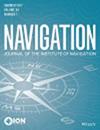保护隐私的协同GNSS定位
IF 2
3区 地球科学
Q1 ENGINEERING, AEROSPACE
引用次数: 0
摘要
摘要本文解决了协同定位环境下的用户隐私问题,其中信息在多个协作代理之间传递和处理,目标是实现高水平的定位精度。本文重点讨论了基于差分全球导航卫星系统(GNSS)和基于GNSS的协同定位方法下的三种隐私保护方案。所讨论的体系结构提供相同的定位结果,同时为合作用户提供不同级别的隐私。随着隐私的增长以及非加密、加密和同态加密解决方案的实现,这些体系结构的复杂性也会增加。后一种方案对计算量的要求最高;然而,它通过采用同态加密提供了最高级别的隐私,因此可以对加密数据执行加法和乘法操作以产生加密输出,而不会泄露有关协作代理位置的信息。所提出的保护隐私的合作位置方案在提供隐私保证的同时,与非保护隐私的合作位置方案提供相同的结果。基于此分析,可以考虑将所提出的一些解决方案用于实时应用程序,而同态加密对于容忍延迟的应用程序是一种有效的解决方案。在不久的将来,计算能力的进步将提高它们的整体可用性。本文章由计算机程序翻译,如有差异,请以英文原文为准。
Privacy-Preserving Cooperative GNSS Positioning
Abstract
The issue of user privacy in the context of collaborative positioning is addressed in this work, wherein information is passed between and processed by multiple cooperative agents, with the goal of achieving high levels of positioning accuracy. In particular, this paper discusses three privacy-preserving schemes in the context of differential global navigation satellite system (GNSS)-based and GNSS-based cooperative positioning methods. The discussed architectures provide the same positioning results, while yielding different levels of privacy to the cooperative users. These architectures also involve increased complexity as privacy grows and as non-encrypted, encrypted, and homomorphically encrypted solutions are implemented. The latter scheme is the most computationally demanding; however, it provides the highest level of privacy by employing homomorphic encryption, whereby addition and multiplication operations may be performed on encrypted data to produce encrypted outputs, without revealing information about the collaborative agent’s location. The proposed privacy-preserving cooperative position schemes are shown to provide the same results as their non-privacy-preserving counterparts, while providing privacy guarantees. Based on this analysis, some of the proposed solutions can be considered for real-time applications, while homomorphic encryption is a valid solution for latency-tolerant applications. Advances in computing power will increase their overall usability in the near future.求助全文
通过发布文献求助,成功后即可免费获取论文全文。
去求助
来源期刊

Navigation-Journal of the Institute of Navigation
ENGINEERING, AEROSPACE-REMOTE SENSING
CiteScore
5.60
自引率
13.60%
发文量
31
期刊介绍:
NAVIGATION is a quarterly journal published by The Institute of Navigation. The journal publishes original, peer-reviewed articles on all areas related to the science, engineering and art of Positioning, Navigation and Timing (PNT) covering land (including indoor use), sea, air and space applications. PNT technologies of interest encompass navigation satellite systems (both global and regional), inertial navigation, electro-optical systems including LiDAR and imaging sensors, and radio-frequency ranging and timing systems, including those using signals of opportunity from communication systems and other non-traditional PNT sources. Articles about PNT algorithms and methods, such as for error characterization and mitigation, integrity analysis, PNT signal processing and multi-sensor integration, are welcome. The journal also accepts articles on non-traditional applications of PNT systems, including remote sensing of the Earth’s surface or atmosphere, as well as selected historical and survey articles.
 求助内容:
求助内容: 应助结果提醒方式:
应助结果提醒方式:


